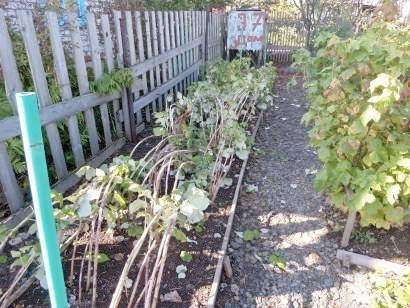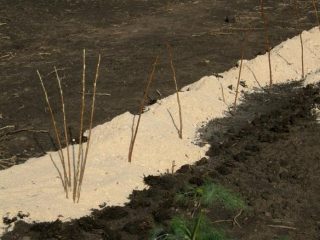Content
It is difficult to imagine a garden without raspberry bushes, because the fruits are liked not only by children, but also by adults. The range of varieties is varied; when choosing, not only the characteristics of the bushes are taken into account, but also the size, taste of the berries, and care features.
Raspberry Volnitsa has long settled in garden plots. The description of the variety, photos and reviews from gardeners presented below are just for those who are not yet familiar with the berry bush. We hope that raspberries will gain new fans.
A little history
The first description of the raspberry variety was given in 1994. Volnitsa was created by scientific breeders from Bryansk S. D. Aitzhanova, V. L. Kulagina under the leadership of I. V. Kazakov. They are the “parents” of many non-remontant raspberry varieties, including Volnitsa.
An interesting parental chain is being built: “father and mother” are the Bryansk and Brigantine. And the “grandmother” of Volnitsa is called Novost Kuzmina (an ancient Russian variety), it is from her that the Bryansk raspberry was obtained.
Description
The raspberry variety Volnitsa is not remontant.The plant is recommended for cultivation in almost all regions of Russia. Descriptions, photos and reviews from gardeners will help you understand the characteristics of the variety.
Bushes
Raspberry Volnitsa is of medium height, reaches 170-200 cm. The shoots are slightly inclined, as if freely scattered, hence the name. Attention! The Volnitsa variety bears fruit on shoots of the second year of life.
The stems of the raspberry variety are medium thick, at first brown with a waxy coating, the next year they are light brown. The shoots are covered from top to bottom with purple thorns, but they are small and not very prickly. There are many leaves, they are densely located. The leaf blades are rich green in color with clearly visible corrugation. The curl of raspberry leaves is average.
As gardeners note in the reviews, and this is noticeable in the photo of the Volnitsa variety, there is no particular thickening of the bush. After all, the growth of replacement shoots in the Volnitsa raspberry is moderate, no more than nine per season.
That is why the mother bush receives enough nutrition and devotes all its energy to fruiting. Although, if it is necessary to quickly propagate the Volnitsa raspberry variety on a large scale, there will not be enough planting material.
The branches on which the inflorescences appear are long and powerful. As a rule, up to 10-12 tassels are formed on one shoot, on which up to 20 berries are tied, as in the photo below.
Fruit
The berries of the variety are attractive in appearance and have the shape of a blunt cone. As gardeners note in reviews, Volnitsa raspberry fruits always correspond to the description: they are smooth, without the slightest deviation. The weight of the berries ranges from 3-5 grams. The drupes are the same size, hold tightly to each other, and do not fall off even after the raspberries are overripe.
When ripe, the fruits change color from light crimson to bright red. On the surface of the berries there is slight pubescence, inherited from the Volnitsa variety from the Novosti Kuzmina raspberry, which is considered the “grandmother”. This feature of raspberry fruits is clearly visible in the photo.
The taste of raspberries is sweet and sour, the aroma is subtle, barely noticeable. The pulp is tender and juicy. Each drupe has seeds, but they are so small that they are not felt when eaten. Tasters rate the taste of Volnitsa raspberries with four points out of five.
Characteristics
Based on the description and photo, you can imagine Volnitsa raspberries visually, but without characteristics it is difficult to make a choice of variety for cultivation. Therefore, the characteristics of the plant are given below, and the advantages and disadvantages are indicated.
Advantages of the variety
- Raspberry ripening period is mid-early, fruiting is extended.
- The yield is stable, up to 4 kg of tasty fruits are collected from the bush. If all agricultural standards are observed, a higher yield can be obtained.
- The berries of the Volnitsa variety have universal use. Raspberries are good not only fresh. The fruits make delicious jam and compote. Frozen and dried berries retain all their beneficial properties.
- Even overripe raspberries from the collection of I.V. Kazakov do not fall off, which is very attractive for gardeners who do not have the opportunity to collect fruits as they ripen.
- The transportability of the variety is good. If the berry is not removed from the stalk, it means it is not yet ripe.
- The Volnitsa variety is frost-resistant, winters well at temperatures up to 30 degrees, so raspberries can be grown in almost all regions of Russia.
- Many raspberry diseases bypass bushes and fruits. The most annoying pest is the kidney mite.
Minuses
Gardeners who have been working with the Volnitsa variety for many years do not note any particular shortcomings; reviews are mostly positive. If we talk about the disadvantages of raspberries, they are as follows:
- Spreading and tall bushes need staking.
- The yield of Volnitsa raspberries, compared to modern varieties, is not so high.
- The presence of spines along the entire length of the shoot.
Site selection
Raspberries are planted in fertile soil that has enough moisture. But groundwater should not come close to the root system, since fungal diseases can occur in swampy soil. Removed before planting weeds.
If the soil is peaty, then you need to add clay and manure. This organic matter will contribute to the development of microorganisms that decompose peat. When choosing a site for Volnitsa raspberries, they also take into account the fact that low places for planting are undesirable, since the bushes can be damaged by frost.
The best place to plant raspberries is along the fence on the south side of the site. In this case, the plants will be evenly illuminated throughout the day.
Helpful Tips:
Accommodation options
The method of planting Volnitsa raspberries depends on the size of the plot. You can grow free-standing bushes or in a trench:
- Planting with individual bushes. It is necessary to dig 40x50 cm holes for the plants. Each of them is first filled with drainage and then with fertile soil. There should be at least 100 cm between raspberry bushes, and up to two meters between rows. This distance is necessary for caring for plantings.
- Into the trench. The trench method of growing raspberries of any variety is the most common. This placement of bushes is more economical.The ditches for planting raspberries are located from north to south. The trenches should be 50 cm wide and at least 45 cm deep. When planting, leave 40 cm between the bushes, and dig the next trench after 100 cm.
Drainage must be laid at the bottom of the trench. Fertile soil is poured on top, which includes organic matter or mineral fertilizers (depending on the preferences of the gardeners).
Landing Features
Volnitsa raspberries can be planted in spring or autumn. But it is autumn planting that is considered the best option. You need to start work before the soil freezes so that the root system has time to take root. If you plant raspberries in the spring, then it is very early, before the buds wake up.
Preparation of seedlings
Before planting, you need to prepare not only the soil, but also the planting material. All shoots of the seedling are cut off, leaving only one, the strongest one. In addition, it is necessary to shorten the stem to a height of 20 cm.
Even if the planting material was taken directly from the garden bed, it still needs to be soaked in a nutrient mixture of mullein and clay. This procedure will strengthen the seedling’s immunity and it will take root better.
How to plant raspberries correctly:
- Drainage needs to be laid at the bottom. Many gardeners advise using so-called firewood. These are twigs left over from pruning trees or pieces of boards or wood chips. They will decompose slowly, and bacteria developing on the tree will process organic matter into nutrients.
- The soil for filling a hole or trench is prepared from humus and compost. The drainage is sprinkled with a layer of soil and filled well with water. Superphosphate or potassium fertilizer is added on top.And only then a layer of fertile soil. The roots of a raspberry seedling should not come into contact with mineral fertilizers to avoid getting burned.
A mound is made in the center of the planting site and seedlings are planted on it. Soil is poured on top and compacted well to squeeze out air from under the raspberry root system. Abundant watering will allow the roots to better adhere to the soil. When planting, the root collar of the seedling should be higher than the soil. It will settle a little after watering.
To retain moisture, the soil around the plantings is mulched with sawdust, straw or manure. If raspberries were planted in October or early November (depending on the region), then the roots of the plant are covered 10 centimeters deep. This is necessary to cover the buds.
Features of care
There are no particular difficulties when growing the plant. Even novice gardeners manage to get good harvests:
- Since the Volnitsa raspberry variety is tall, it requires staking. Plants grown by the trench method are secured to a trellis. A reliable stake is driven in next to single plantings.
- Like any plants, plantings are watered as needed. The Volnitsa raspberry variety especially needs moisture during flowering and fruiting. In hot weather, watering is increased; you can also water the plants over the leaves early in the morning or after sunset.
- Volnitsa loves loose soil and does not tolerate weeds. Both types of work are performed after watering. Fertilizers are also applied to well-moistened soil twice a year: in July and August. The variety responds well to infusions of mullein, bird droppings and green grass.
- Sanitary pruning of bushes is carried out in the spring, removing diseased and frozen shoots. In summer, grown replacement branches are cut off so that they can branch out.This procedure also allows the shoots to ripen well before winter.
- The Volnitsa variety can bear fruit in one place for up to 15 years. It is clear that during this time diseases and pests accumulate, despite resistance and good immunity. Therefore, preventive procedures are an integral part of planting care. Traditional medications are used, taking into account the recommendations for use.
Preparing for winter
In the fall, fruit-bearing raspberry shoots are cut out at the root, and the young ones are bent to the ground. Work is carried out before the onset of frost. Flexible shoots are easy to lay and do not break.
In regions with abundant snow, there are fewer problems: it is enough to add it in winter. If the winters have little snow, the raspberries are covered with non-woven material, topped with spruce branches, or earth. Full cover is carried out with the onset of stable cold weather.
Reviews



















